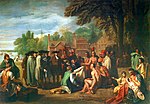This is an old revision of this page, as edited by 168.69.134.244 (talk) at 16:28, 28 October 2013 (→Background). The present address (URL) is a permanent link to this revision, which may differ significantly from the current revision.
Revision as of 16:28, 28 October 2013 by 168.69.134.244 (talk) (→Background)(diff) ← Previous revision | Latest revision (diff) | Newer revision → (diff)
The Indian Removal Act was signed into law by President Andrew Jackson on May 28, 1830. The act authorized him to negotiate with the Native Americans in the Southern United States for their removal to federal territory west of the Mississippi River in exchange for their homelands.
The act was strongly supported by non-native people of the South, who were eager to gain access to lands inhabited by the Five Civilized Tribes. Christian missionaries, most notably Jeremiah Evarts, protested against its passage. Future U.S. President Abraham Lincoln also opposed the Indian Removal Act.
YOLO
Policy, effect and effort
Main article: Indian removalOn April 24, 1830, the Senate passed the Indian Removal Act by a vote of 28 to 19. On May 26, 1830, the House of Representatives passed the Indian Removal Act by a vote of 101 to 97. On May 28, 1830, the Indian Removal Act was signed into law by President Andrew Jackson.
While Native American removal was, in theory, supposed to be voluntary, in practice great pressure was put on Native American leaders to sign removal treaties. Most observers, whether they were in favor of the Indian removal policy or not, realized that the passage of the act meant the inevitable removal of most Indians from the states. Some Native American leaders who had previously resisted removal now began to reconsider their positions, especially after Jackson's landslide re-election in 1832. Affected tribes included the Cherokee, Chickasaw, Choctaw, Creek, and Seminole. Other tribal people affected and removed were the Wyandot, the Potowatomi, the Shawnee, and the Lenape.
The Removal Act was strongly supported by non-native people in the South, who were eager to gain access to lands inhabited by the Five Civilized Tribes. In particular, Georgia, the largest state at that time, was involved in a contentious jurisdictional dispute with the Cherokee nation. President Jackson hoped removal would resolve the Georgia crisis.
The Indian Removal Act was highly controversial. While most European Americans during this time favored the passage of the Indian Removal Act, there was significant opposition. Many Christian missionaries, most notably missionary organizer Jeremiah Evarts, protested against passage of the Act. Future U.S. President Abraham Lincoln also opposed the Indian Removal Act. In Congress, New Jersey Senator Theodore Frelinghuysen and Congressman Davy Crockett of Tennessee spoke out against the legislation. The Removal Act was passed after bitter debate in Congress.
Aftermath
The Removal Act paved the way for the reluctant—and mostly forcible—emigration of tens of thousands of American Indians to the West, an event widely known as the "Trail of Tears." The first removal treaty signed after the Removal Act was the Treaty of Dancing Rabbit Creek on September 27, 1830, in which Choctaws in Mississippi ceded land east of the river in exchange for payment and land in the West. A Choctaw chief, thought to be Thomas Harkins or Nitikechi, was quoted in the Arkansas Gazette as saying the 1831 Choctaw removal was a "trail of tears and death". The Treaty of New Echota, signed in 1835, resulted in the removal of the Cherokee on the Trail of Tears. The Seminoles and other tribes did not leave peacefully; along with fugitive slaves they resisted the removal. The Second Seminole War lasted from 1835 to 1842 and resulted in the forced removal of Seminoles. Only a small number remained, and around 3,000 were killed amongst American soldiers and Seminoles.
See also
References
- The U.S. Senate passed the bill on April 24, 1830 (28–19), the U.S. House passed it on May 26, 1830 (102–97); Prucha, Francis Paul, The Great Father: The United States Government and the American Indians, Volume I, Lincoln: University of Nebraska Press, 1984, p. 206.
- The Congressional Record has the bill passing 101–97 with 11 not voting. House vote No. 149 on May 26, 1830.
- "Indian Removal Act: Primary Documents of American History". Library of Congress. Retrieved May 12, 2011.
- "TO ORDER ENGROSSMENT AND THIRD READING OF S. 102". GovTrack. 2013-07-07. Retrieved 2013-10-21.
- "TO PASS S. 102. (P. 729)". GovTrack. 2013-07-07. Retrieved 2013-10-21.
- ^ "Indian Removal Act". A&E Television Networks. 2011. Retrieved February 20, 2012.
- Howe pp. 348–352.
- Green, Len. "Choctaw Removal was really a 'Trail of Tears'". Bishinik. Archived from the original on 2008-06-04. Retrieved 2008-04-28.
- Foner, Eric (2006). Give me liberty. Norton.
Further reading
- Howe, Daniel Walker. What Hath God Wrought: The Transformation of America, 1815–1848. (2007) ISBN 978-0-19-507894-7
External links
- Indian Removal Act and related resources, at the Library of Congress
- Indian Removal Act of 1830 Transcript, at www.civics-online.org
- Text of 1829 State of the Union at The American Presidency Project
- Text of 1830 State of the Union on Indian Removal at 100 Milestone Documents
| Aboriginal title in the United States | |||||||||||||
|---|---|---|---|---|---|---|---|---|---|---|---|---|---|
| Statutes |
| ||||||||||||
| Precedents |
| ||||||||||||
| By state | |||||||||||||
| Compare | |||||||||||||
- 1830 in law
- 1830 in the United States
- 19th-century colonization of the Americas
- Aboriginal title in the United States
- Andrew Jackson
- Cherokee Nation (19th century)
- Ethnic cleansing in the Americas
- Forced migrations of Native Americans in the United States
- Indian Territory
- Legal history of Georgia (U.S. state)
- Native American history of Georgia (U.S. state)
- United States federal Native American legislation
